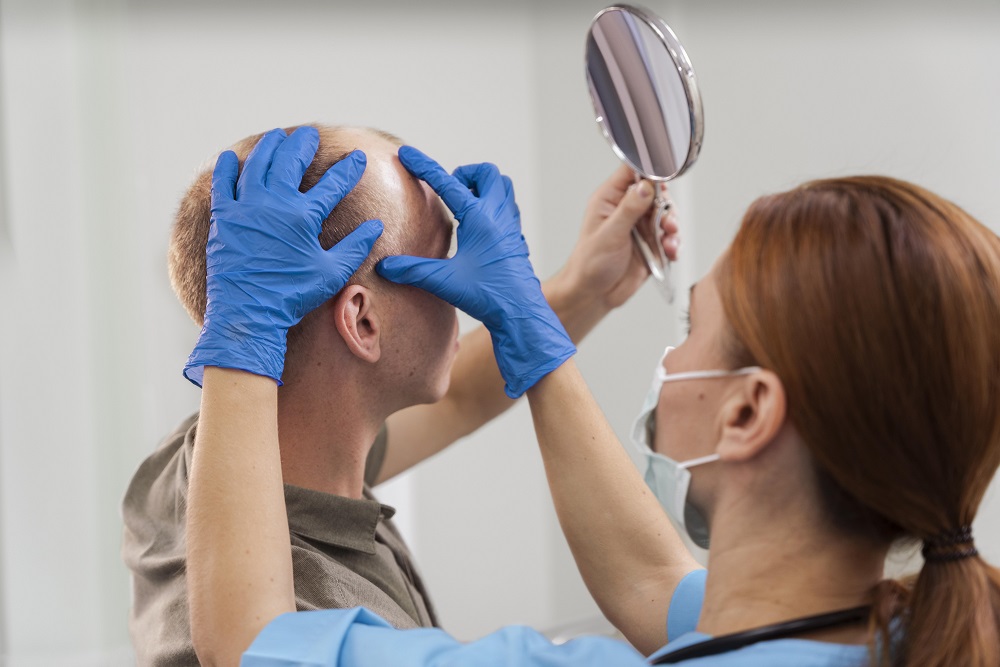
Men and women seeking hair restoration often consider surgical intervention without a professional and ethical evaluation.
We always encourage patients searching for hair transplant to consult in person with our hair transplant surgeon and dermatologist.
Your candidacy for hair transplant is identified as per the steps discussed below:
Step 1: Diagnosis of Hair Loss
The fundamentals of hair transplant begin with the diagnosis of hair loss, ascertaining the candidate’s hair loss pattern, ruling out causes like alopecia areata, scarring alopecia (active), telogen effluvium, etc. Other medical conditions like diabetes, thyroid, anxiety disorders, nutritional deficiency, and keloidal tendency are factored in before prescribing a treatment plan.
The dermatologists at Dr. Haror’s Wellness are well qualified and trained to give an expert diagnosis of hair loss and prescribe the best treatment.
Step 2: Grading the Baldness
Men’s hair loss is graded on a standard Norwood scale of II-VII and women on Ludwig Scale of 1A-III to measure the extent of hair loss. Hair Transplant is primarily suggested at Grade III and onwards stage in men. Female hair loss on grade 1 is treated with medical treatment, and transplant is suggested at grade II after evaluating aspects like donor area and response to medical treatment.
Hair transplant, being an elective surgery, is prospected only after a detailed analysis and prognosis of hair loss. At Dr. Haror’s Wellness, we employ the best practices of medical loss treatment.
Step 3: Assessment of the Donor Area
While suggesting hair transplant for the required number of hair grafts, it is very imperative to assess the safe zone of the donor area and its capacity to provide optimal density and desired coverage of baldness.
We use tools like magnifiers and densitometers to estimate the approximate number of hairs in the graft. Available hair is a limited resource, and the feasibility of hair transplant is often decided by this exercise. It helps our hair transplant surgeon to get an approximation of graft consumption as well as alignment with expected results.
Step 4: Understanding and Aligning the Patient’s Expectation from the Treatment
Every hair transplant patient and their expectations are different, and our consultants are trained in communication to drive the aspirations. A practice documentation of hair loss history and treatment plan.
Step 5: Hair Line Sketch Illustration in Consensus with the Candidate’s Profile
We believe that the hairline occupies a significant part of a successful hair transplant. It conveys the craft and perfection of hair transplantation.
A sketch illustration helps the candidate in visualizing the coverage and hairline shape, remaining a significant part of documenting the advice.
Dr. Haror’s Wellness is considered to have a transparent approach in patient management and encourages the candidate to ask questions and clear doubts before submitting their head for a hair transplant procedure. Always take an informed decision.
Cost of Hair Transplant in Delhi
New Delhi, the capital of India, has become a preferred destination for hair transplant due to its combination of high-quality services, experienced surgeons, and affordable prices. The country’s medical tourism industry is well-regulated, ensuring that clinics adhere to strict standards of safety and quality. The key advantages of having a hair transplant in Delhi are the cost. The prices are significantly lower than in countries like the United States and Europe, even when considering travel and accommodation expenses. This affordability doesn’t compromise the quality of care, as clinics use the latest technology and techniques of Hair Transplant
Choosing a Hair Transplant Clinic in Delhi
It’s essential to research thoroughly while choosing a clinic in New Delhi. Look for clinics that have a good reputation, positive patient reviews, and experienced surgeons.
Always consider the clinic where the approach is pro-patient and after-care services are professional. Good clinics offer comprehensive consultations, personalized treatment plans, and post-operative care. They should also be transparent about the costs of hair transplant and potential risks of the procedure.





